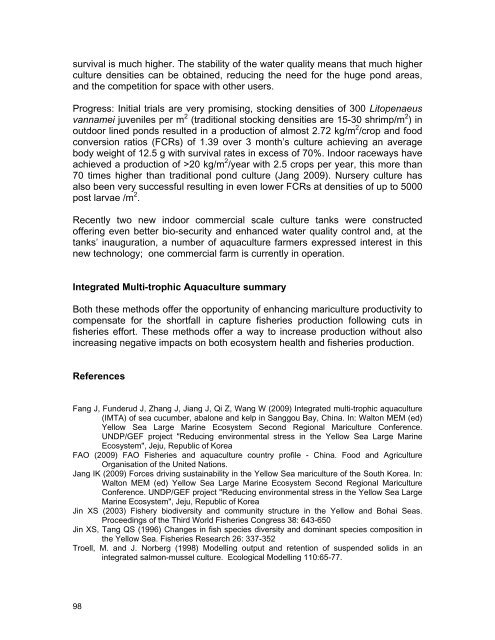Sustaining the World's Large Marine Ecosystems
Sustaining the World's Large Marine Ecosystems
Sustaining the World's Large Marine Ecosystems
Create successful ePaper yourself
Turn your PDF publications into a flip-book with our unique Google optimized e-Paper software.
survival is much higher. The stability of <strong>the</strong> water quality means that much higher<br />
culture densities can be obtained, reducing <strong>the</strong> need for <strong>the</strong> huge pond areas,<br />
and <strong>the</strong> competition for space with o<strong>the</strong>r users.<br />
Progress: Initial trials are very promising, stocking densities of 300 Litopenaeus<br />
vannamei juveniles per m 2 (traditional stocking densities are 15-30 shrimp/m 2 ) in<br />
outdoor lined ponds resulted in a production of almost 2.72 kg/m 2 /crop and food<br />
conversion ratios (FCRs) of 1.39 over 3 month’s culture achieving an average<br />
body weight of 12.5 g with survival rates in excess of 70%. Indoor raceways have<br />
achieved a production of >20 kg/m 2 /year with 2.5 crops per year, this more than<br />
70 times higher than traditional pond culture (Jang 2009). Nursery culture has<br />
also been very successful resulting in even lower FCRs at densities of up to 5000<br />
post larvae /m 2 .<br />
Recently two new indoor commercial scale culture tanks were constructed<br />
offering even better bio-security and enhanced water quality control and, at <strong>the</strong><br />
tanks’ inauguration, a number of aquaculture farmers expressed interest in this<br />
new technology; one commercial farm is currently in operation.<br />
Integrated Multi-trophic Aquaculture summary<br />
Both <strong>the</strong>se methods offer <strong>the</strong> opportunity of enhancing mariculture productivity to<br />
compensate for <strong>the</strong> shortfall in capture fisheries production following cuts in<br />
fisheries effort. These methods offer a way to increase production without also<br />
increasing negative impacts on both ecosystem health and fisheries production.<br />
References<br />
Fang J, Funderud J, Zhang J, Jiang J, Qi Z, Wang W (2009) Integrated multi-trophic aquaculture<br />
(IMTA) of sea cucumber, abalone and kelp in Sanggou Bay, China. In: Walton MEM (ed)<br />
Yellow Sea <strong>Large</strong> <strong>Marine</strong> Ecosystem Second Regional Mariculture Conference.<br />
UNDP/GEF project "Reducing environmental stress in <strong>the</strong> Yellow Sea <strong>Large</strong> <strong>Marine</strong><br />
Ecosystem", Jeju, Republic of Korea<br />
FAO (2009) FAO Fisheries and aquaculture country profile - China. Food and Agriculture<br />
Organisation of <strong>the</strong> United Nations.<br />
Jang IK (2009) Forces driving sustainability in <strong>the</strong> Yellow Sea mariculture of <strong>the</strong> South Korea. In:<br />
Walton MEM (ed) Yellow Sea <strong>Large</strong> <strong>Marine</strong> Ecosystem Second Regional Mariculture<br />
Conference. UNDP/GEF project "Reducing environmental stress in <strong>the</strong> Yellow Sea <strong>Large</strong><br />
<strong>Marine</strong> Ecosystem", Jeju, Republic of Korea<br />
Jin XS (2003) Fishery biodiversity and community structure in <strong>the</strong> Yellow and Bohai Seas.<br />
Proceedings of <strong>the</strong> Third World Fisheries Congress 38: 643-650<br />
Jin XS, Tang QS (1996) Changes in fish species diversity and dominant species composition in<br />
<strong>the</strong> Yellow Sea. Fisheries Research 26: 337-352<br />
Troell, M. and J. Norberg (1998) Modelling output and retention of suspended solids in an<br />
integrated salmon-mussel culture. Ecological Modelling 110:65-77.<br />
98









